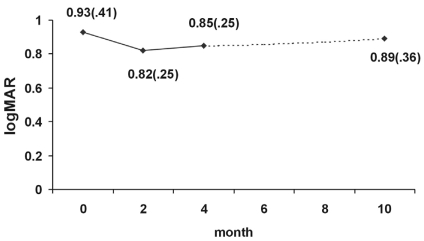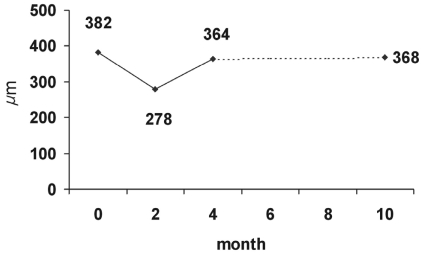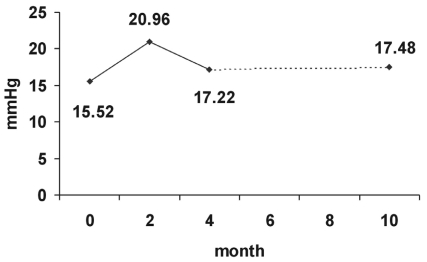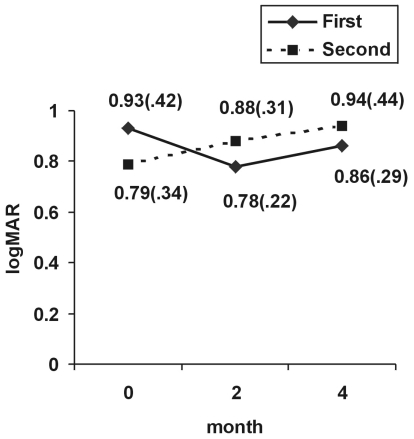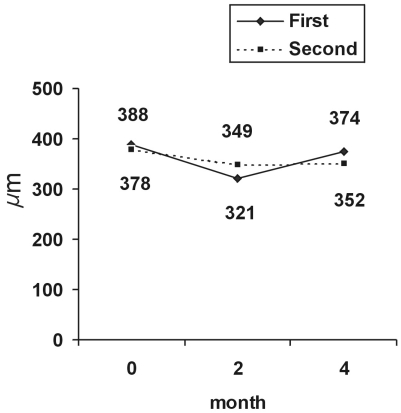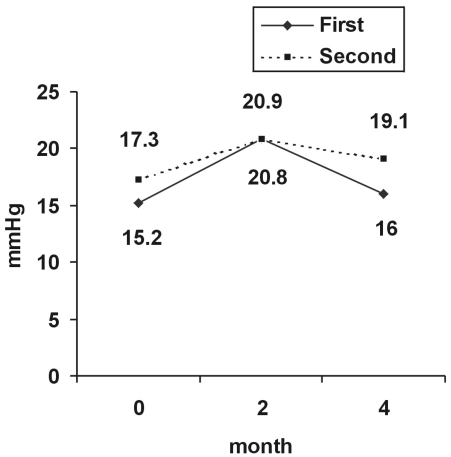Korean J Ophthalmol.
2006 Sep;20(3):156-161. 10.3341/kjo.2006.20.3.156.
Intravitreal Triamcinolone Reinjection for Refractory Diabetic Macular Edema
- Affiliations
-
- 1Ophthalmic Research Center, Shaheed Beheshti University of Medical Sciences, Tehran, Iran. arramezani@gmail.com
- KMID: 754572
- DOI: http://doi.org/10.3341/kjo.2006.20.3.156
Abstract
- PURPOSE: To evaluate the effect of intravitreal triamcinolone acetonide (IVT) reinjection on clinical and optical coherence tomographic features in refractory diabetic macular edema. METHODS: In a prospective interventional case series, all IVT treated patients enrolled in a previous clinical trial were recalled to have a new ophthalmologic examination and optical coherence tomography (OCT) performed. Eyes found suitable for reinjection received 4 mg IVT. Complete clinical examination and OCT were repeated at 2 and 4 months post-injection. The changes were statistically analyzed using a paired t test and were compared to the results of the first injections. RESULTS: Of all returning patients, 12 cases with complete records were considered candidates for reinjection. Visual acuity (VA) changes were not significant after the first and second interventions, although there was a relative improvement (0.14 logMAR) 2 months after the first injection. Reductions of central macular thickness (CMT) were 43+/-69 micrometer, and 40+/-69 micrometer after the first injection and 27+/-48 micrometer, 49+/-58 micrometer after the reinjection at 2 and 4 months, respectively. None of the mentioned changes was significant. After the second injection, however, intraocular pressure was elevated at both 2 and 4 months (3.6 and 2.4 mmHg respectively, P<0.05). Two months after the first administration, intraocular pressure was found to be raised significantly (5.58 mmHg, P=0.001). CONCLUSIONS: The transient beneficial effects of IVT on diabetic macular edema are not repeated with second injections. However, IVT-related ocular hypertension is more persistent after reinjection.
Keyword
MeSH Terms
-
Vitreous Body
Visual Acuity
Triamcinolone/*administration & dosage
Treatment Outcome
Tomography, Optical Coherence
Time Factors
Retreatment
Prospective Studies
Male
Macular Edema, Cystoid/*drug therapy/etiology/pathology
Intraocular Pressure
Injections
Humans
Glucocorticoids/*administration & dosage
Follow-Up Studies
Female
Diabetic Retinopathy/*complications/pathology
Figure
Reference
-
1. William E, Benson . Diabetic Retinopathy. Duane's Clinical Ophthalmology [book on CD-ROM]. 2004. Lippincott: Williams & Wilkins Publishers;chap 30.2. Jonas JB, Kreissig I, Sofker A, Degenring RF. Intravitreal injection of triamcinolone for diabetic macular edema. Arch Ophthalmol. 2003; 121:57–61. PMID: 12523885.3. Martidis A, Duker JS, Greenberg PB, et al. Intravitreal triamcinolone for refractory diabetic macular edema. Ophthalmology. 2002; 109:920–927. PMID: 11986098.
Article4. Ciardella AP, Klancnik J, Schiff W, et al. Intravitreal triamcinolone for the treatment of refractory diabetic macular oedema with hard exudates: an optical coherence tomography study. Br J Ophthalmol. 2004; 88:1131–1136. PMID: 15317702.
Article5. Sutter FK, Simpson JM, Gillies MC. Intravitreal triamcinolone for diabetic macular edema that persists after laser treatment: three-month efficacy and safety results of a prospective, randomized, double-masked, placebo-controlled clinical trial. Ophthalmology. 2004; 111:2044–2049. PMID: 15522370.6. Jonas JB, Degenring RF, Kamppeter BA, et al. Duration of the effect of intravitreal triamcinolone acetonide as treatment for diffuse diabetic macular edema. Am J Ophthalmol. 2004; 138:158–160. PMID: 15234306.
Article7. Jonas JB, Kreissig I, Degenring R. Intraocular pressure after intravitreal injection of triamcinolone acetonide. Br J Ophthalmol. 2003; 87:24–27. PMID: 12488256.
Article8. Jonas JB, Degenring RF, Kamppeter BA, et al. Duration of the effect of intravitreal triamcinolone acetonide as treatment for diffuse diabetic macular edema. Am J Ophthalmol. 2004; 138:158–160. PMID: 15234306.
Article9. Beer PM, Bakri SJ, Singh RJ, et al. Intraocular concentration and pharmacokinetics of triamcinolone acetonide after a single intravitreal injection. Ophthalmology. 2003; 110:681–686. PMID: 12689886.
Article10. Jonas JB. Intraocular availability of triamcinolone acetonide after intravitreal injection. Am J Ophthalmol. 2004; 137:560–562. PMID: 15013884.
Article11. Diabetic retinopathy clinical research network. A randomized trial comparing intravitreal triamcinolone acetonide and laser photocoagulation for diabetic macular edema. Version 4.0. 2005. chap. 1.
- Full Text Links
- Actions
-
Cited
- CITED
-
- Close
- Share
- Similar articles
-
- The Effect of Intravitreal Triamcinolone Acetonide Injection according to the Diabetic Macular Edema Type
- Intravitreal and Additional Posterior Subtenon Triamcinolone Injection in Diabetic Macular Edema
- Short-Term Results of Dexamethasone Intravitreal Implant in Patients with Refractory Diabetic Macular Edema
- Intravitreal Injection of Triamcinolone for Refractory Diabetic Macular Edema
- Comparison of Intravitreal Bevacizumab Alone Injection and Intravitreal Combination Low-Dose Bevacizumab-Triamcinolone Injection or Diabetic Macular Edema

